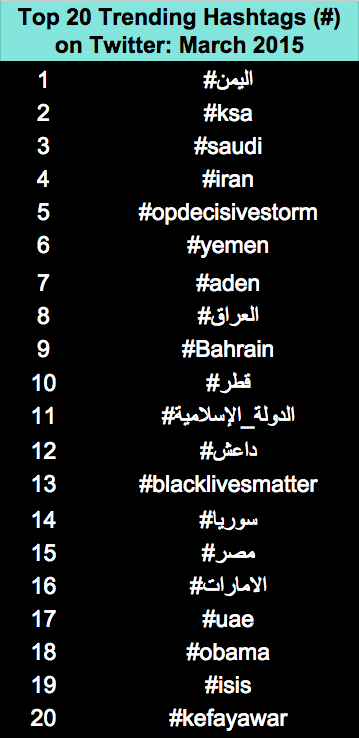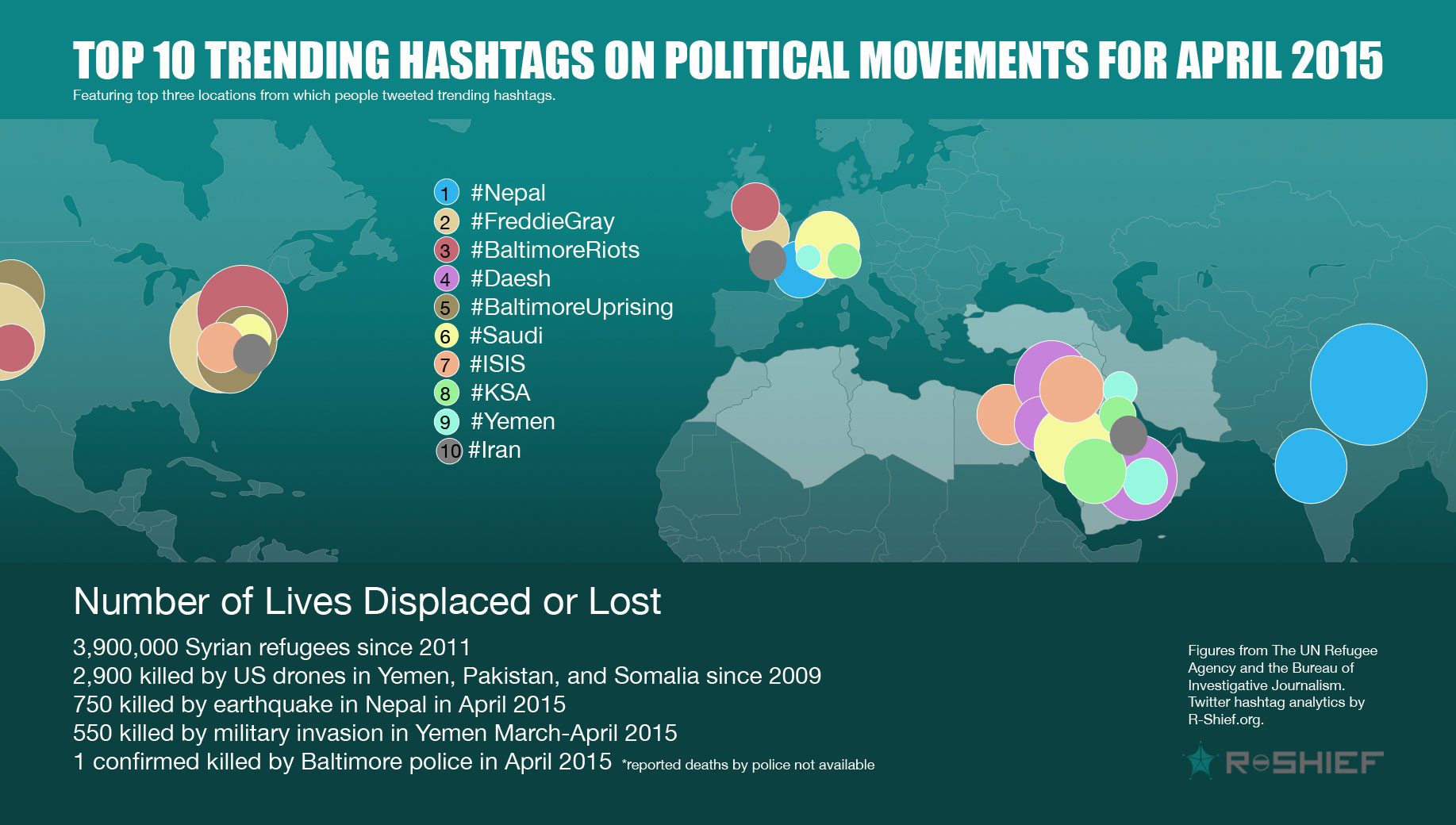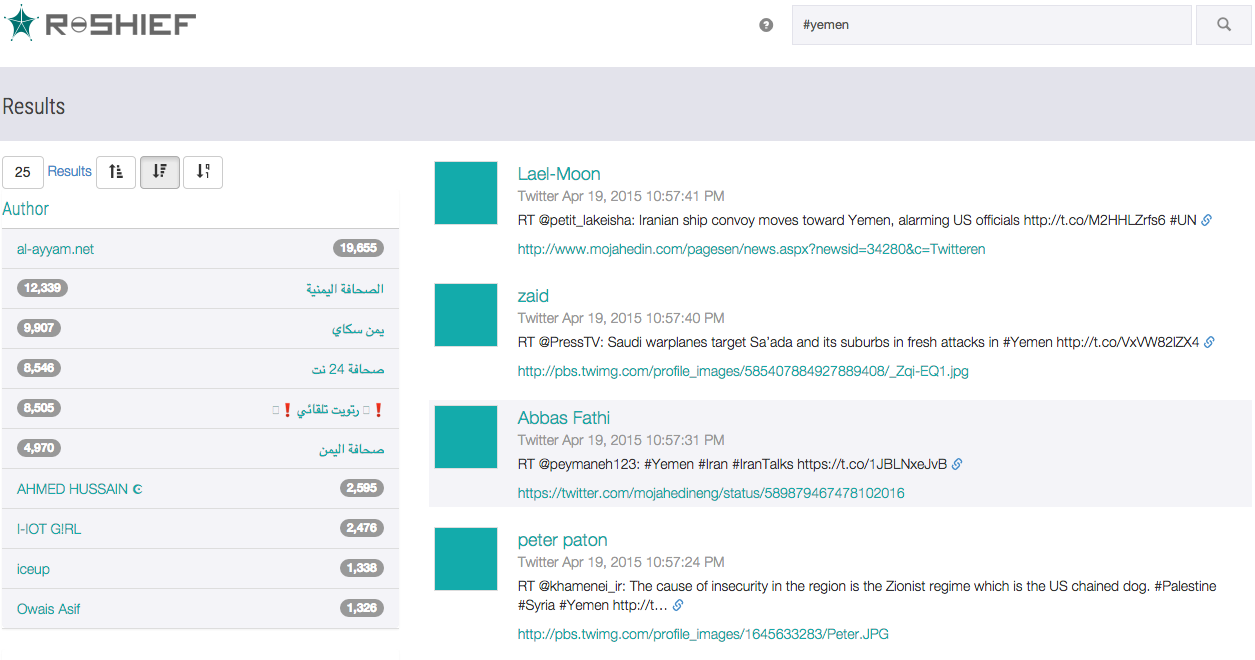"What is Trending on Social Media in the Middle East?" is a regular feature of the "Quick Thoughts" special segment on Status. It offers insight into subjects that dominate online discussion in the Middle East. Every month, Laila Shereen Sakr, who monitors, collects, and analyzes social media trends for R-Shief, will provide an update on what`s trending, and we will speak to her for every episode of Status.
The data visualizations for this episode illustrate the patterns of hashtag use in the Middle East pertaining to various topics in the months of March and April 2015. Created by R-Shief, these visualizations show the top hashtags and most tweeted videos for this period. Laila Shereen Sakr`s comments explain these visualizations, highlight the most compelling aspects of these trending hashtags, and offer insight into how they should be understood.
For more on what defines a trend, see the first "What`s Trending?" report on Jadaliyya.

March 2015
The Saudi-led invasion of Yemen has also swept across the Twitter-sphere in March 2015. The top seven hashtags were all about Yemen and Saudi Arabia: #اليمن, #ksa, #saudi, #iran, #opdecisivestorm, #yemen, #aden -- with most other hashtags paling in comparison. See interactive real-time comparison visualizer.

Figure 1. Word cloud based on top 1,000 tweets in March 2015 in the R-Shief collection on the Middle East.
For now, there are a few interesting points worth mentioning.
- When graphing the hashtags over the last thirty days, it is clear that the most amount of activity was on the first day of the attacks, March 26th. But only a few days later, the number of tweets diminished considerably. This highlights one question that deserves further research and thought: how do short-lived critical issues such as war exist in the virtual world?

Figure 2. Comparing hashtags in March.
- One of the most common other hashtags found among collections of #Saudi or #Yemen tweets are ones pertaining to Iran. #Iran appears as the fourth most trending hashtag this month.
- The most frequently tweeted link on #Yemen is about Iran. The most frequently tweeted links among #Saudi tweets is a series of YouTube videos. And the most tweeted links on #Iran are from the mojahedin.com website. Check out R-Shief’s interactive tool for yourself and you can analyze various words to find the most tweeted images and links.
You can also interact directly with our Search Tool for a faceted search through the last thirty days of #Yemen tweets.
Figure 3. Screenshot of R-Shief’s search tool, Kal3a.
April 2015
This is the third in a series of monthly social media analytics on the Middle East. March`s social media analysis revealed how the Saudi-led military invasion of Southern Yemen had eclipsed most other discussions on the Middle East on Twitter. This month, I chose to display, or “visualize,” the trending data through two more elaborate data visualizations whose narratives are self-contained.
While each monthly analysis to date has centered on the top trending hashtags on Middle East related subjects on Twitter, in April, the focus has expanded to include political movements in Baltimore and natural disasters such as the earthquake in Nepal and volcano eruption in Chile.
R-Shief has expanded the data set because, as Elizabeth Losh wrote in her article, “Hashtag Feminism and Twitter Activism in India,” “examining the unique rhetorical and indexical strategies associated with establishing resistance and solidarity in short-form online communication with hashtags raises a number of important research questions about new discourse practices within political movements.” For example, it is significant that the hashtag #BaltimoreRiot trended higher than #BaltimoreUprising whose naming convention reflects solidarity with activists or #BaltimoreIntifada (which did not make it in the top ten) yet shows solidarity with the Palestinian uprisings.
Similarly natural disasters reveal solidarity among particular local geographies. For example, the earthquake in Nepal did not trend more than discussion on ISIS in Washington, DC. These bring to bear issues on climate change, and global policies as well.
In the data visualization below, I included two bits of data to cross analyze the trending hashtags: (1) the top three geographic locations from which people tweeted the top hashtags, and (2) a list of figures that reflect the impact on real, human lives.
One of the goals of this month’s data analysis is to bring the data closer to the human experience. Too many times have data scientists fetishized technology over content. And in the video and graphic below, my goal is to demonstrate the significance of big data analysis.

Figure 4. [Click to enlarge.] Top 10 trending hashtags in political movements for April 2015, designed by VJ Um Amel. The figures are from the UN Refugee Agency and the Bureau of Investigative Journalism. Twitter hashtag analytics by R-Shief.org.
The second visualization of big data is this twenty second video mosaic of the top hundred most tweeted videos in a set of over one and half million tweets on #FreddieGray and #BaltimoreUprising over the last three days in April 2015. This more affective video includes an audio clip from Baltimore state attorney Marilyn Mosby’s public speech on 01 May where she announced charges of murder and manslaughter against police officers over the death of Freddie Gray whose spine was broken while in custody. In this video, she addresses “the youth.”
Video Mosaic of Top 100 Vids Tweeted on #FreddieGray #BaltimoreUprising from VJ Um Amel.
